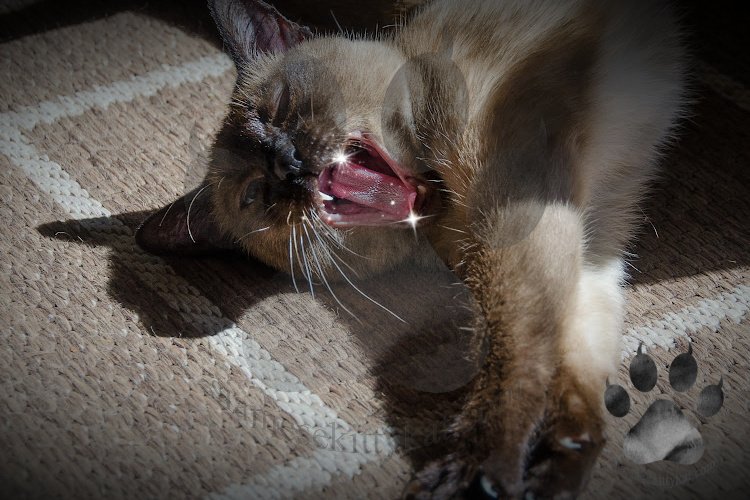Did you know 80% of felines over the age of three have trouble with their teeth and gums? That means eight out of ten kitties could do with a really good brushing – Siamese cats included!
Like our teeth, cats’ teeth can quickly acclimate plaque build-up if not taken care of, leading to tartar and other nasty diseases. Take it from me, someone who fostered a Siamese with periodontal disease caused by a lack of tooth care – it isn’t pretty!
Now, I wouldn’t be surprised if quite a few people were reading this blog and thinking, “wait, I should be brushing my cat’s teeth?!” because, in all honesty, it wasn’t something I was doing until I took my very first Siamese to the vets.
Thankfully, I was told what I should be doing before it was too late, and this is your sign to pick up that kitty toothbrush and start too!
Are you supposed to brush your Siamese cat’s teeth?
Yes! I can’t stress how important it is to keep up on your Siamese cat’s dental hygiene. There are lots of nasty bacteria swimming around inside your cat’s mouth, and when built up, it can cause extreme pain and even tooth loss.
While there are other ways to reduce plaque build-up, brushing your Siamese cat’s teeth has to be the most effective way to maintain long-term dental health.
As amusing as it would be to see our Siamese kitties pick up a toothbrush and go to town, they rely on us to ensure their pearly whites stay nice and healthy.
Now I know what you’re thinking, how on earth do you brush a cat’s teeth without losing all your fingers? Thankfully, the answer to that question is relatively simple; time, patience, and love (and the right tools, of course!)
If you have any concerns about springing a new and possibly stressful brushing routine on your Siamese, speak to your local vet for advice.
Do Siamese cats have bad teeth?
All breeds of cats are susceptible to dental disease; however, the Siamese (as well as the Burmese, Tonkinese, and a few other breeds) are more prone than most. These dental conditions may include feline oral resorptive lesions (FORLs) and stomatitis.
Siamese cats don’t have bad teeth per se, but they can become bad if they are not taken care of properly. This is why brushing your cat’s teeth is essential, as are yearly vet visits where your Siamese can be examined by a professional.
How many teeth do Siamese cats have?

Siamese cats have 30 teeth by the time they reach adulthood, the same amount as any cat should have. Here is a summary of their teeth growing timeline.
Why should I brush my cat’s teeth?
If your cat were a wild beast, they’d spend a fair amount of time chewing on grass and bones, which would usually keep their teeth quite clean. Now, if you have a domestic Siamese like my two kitties, Batman and Robyn, you’ll know that there isn’t really a suitable replacement (and I’m not talking about chewing the side of the sofa, Robyn…)
And while Siamese cats are chatty little creatures, there’s no way for them to tell us with words that they are sick or in pain. That’s why we must keep up on their health routines to stop diseases from occurring in the first place instead of treating them when they come around.
It’s also important to know the tell-tale signs of dental disease in our beloved Siameses. Luckily, that’s what one of the blogs here on my site is all about. Check it out by clicking on the link!
As I mentioned earlier, teeth and gum problems affect eight out of ten cats. This is due to bacteria from their food accumulating in their mouths, creating plaque. Once this bacteria has developed onto tartar, it will irritate their gums and may even cause gingivitis and tooth loss.
If the tartar has been left too long, it can sometimes, in extreme cases, be completely irreversible, resulting in teeth being removed to get rid of the pain.
If your Siamese is suffering from inflammation or pain inside their mouth, it will make it difficult for them to eat or drink. This nasty bacteria can even get into the bloodstream, triggering kidney disease and damaging other organs.
This horrible tooth decay process and destruction of the gums is known as periodontal disease, most common in adult cats and dogs. The good news is this disease is highly preventable as long as you do one thing; dental care!
Why does my Siamese have bad breath?
Have you ever smelt your Siamese breath and thought, phew, what have you been eating?! If they haven’t found their way into the trash recently, they may be suffering from one of the following diseases:
Of course, bad teeth and periodontal disease can cause bad breath, and they’re usually the most common culprits; they aren’t the only cause.
If you’ve noticed your Siamese cat’s breath getting smellier and smellier, it’s time to have them checked out by a vet. And, Siamese cats are prone to certain diseases, so aside from seeking help from medical professionals, it would also help if we as their caretakers are aware of what these diseases are. I researched exactly just that and compiled what I found out through an article here on my site. Simply visit the link if you’d like to read more.
Do not assume that the reason for their breath is due to tooth issues; it could be far worse!
When should I start cleaning my cat’s teeth?
The best time to begin brushing your Siameses’ teeth is when they are kittens. Not only does this reduce the chances of gum disease, but it also puts them in a steady routine where they can see the experience as a positive one, rather than one that will result in a lost finger.
That being said, it is never too late to start. You can brush your adult Siamese cat’s teeth just fine; all you need is patience – and lots of it! If you’ve ever tried to give your Siamese their medication, you’ll know just how stressful it can be (for both you and the kitty.) It’s important to remember just how strange and daunting this can be for your Siamese.
If you want my advice, I suggest taking your Siamese for a dental examination before you start brushing away. This will filter out any pre-existing dental diseases that may cause your Siamese more harm if you brush. Brushing your cat’s teeth after any dental problems have been addressed or have time to heal will increase the chance of the process going smoothly.
How often should you brush a cat’s teeth?

Like their human parents, cats need daily brushing to help keep the plaque and tartar at bay. Getting your Siamese getting used to brushing will take quite some time, especially if they are an adult, so you typically won’t be doing it every day at first (unless your Siamese is an absolute superstar.)
Daily brushing is most beneficial. However, brushing at least three times a week will be helpful if you can’t fit it into your schedule or your Siamese is especially difficult.
What to use to clean your cat’s teeth
Can I use human toothpaste paste on my cat? No, no, no! Things that are designed for us are not intended for our pets. There are specific dental products for cats readily available almost anywhere; ask your vet for recommendations or take a trip down to the pet shop.
You will need:
To make things easier for you, you can pick up starter kits that contain both the appropriate toothbrush and toothpaste. Here are some of the best ones I came across on Amazon:
If your Siamese has previously been for a dental checkup, go with your vet’s recommendations.
How to prepare your cat for brushing their teeth
Let’s face it, the thought of putting your finger anywhere near those sharp weapons is anything but pleasant – if you don’t ease your Siamese into the brushing process, you can easily come out with a few puncture wounds or scratches.
The earlier you start your Siamese off with brushing, the easier it will be for the both of you. If they are older, it will most likely be more challenging; however, with consistency and patience, it should work out just fine.
I know this since even though I’ve been brushing Batman’s and Robyn’s teeth from a young age, I didn’t start brushing my first Siameses teeth until they were about two years old.
In the wild, cats aren’t used to having a bit of plastic with bristles in their mouth, so try to remember this isn’t natural to them. They’ll be confused and curious, so use this curiosity to gain trust slowly.
You should also find a place that gives your Siamese a sense of calm. This could be with them sitting on a cozy blanket when they’re most relaxed or in between a good cuddle with their human – take it from me, it’s in your best interest to create a calm and comfortable environment.
How do you clean Siamese cat’s teeth?
After visiting the vets to give your Siamese the greenlight for brushing, follow these steps:
Step 1 – Lifting your cat’s lips
The first thing you’ll want to do is get your Siamese used to having their mouth touched. You can do this by lifting their lips for a little bit at a time. Ensure you are doing this when they are feeling most comfortable and calm, maybe when they are already on your knee, or you’re petting them on the couch.
Body language is a big factor to watch out for – both yours and theirs. Keep your voice soft and passive while you do this activity. Your Siamese will take cues from your tone and body language. If you seem nervous or stressed, they will mirror that.
As soon as your Siamese shows signs of being fussy, stop touching their mouth. It is okay if you can only lift their lips for a few seconds at a time; the main goal is to ensure they don’t associate this action with something negative. As time goes on, they’ll understand that this action isn’t harmful, and they’ll be more willing to have their teeth cleaned.
Step 2 – Practice holding their head
Once your Siamese is used to having their mouth touched, you can take a few days to familiarise yourself with how you will hold their head. Again, perform this action when they feel safe and comfortable.
It is better to have your Siamese back facing you rather than the front. This will make the process seem less confrontational and will also stop them from wiggling away from you.
Step 3 – Introduce the toothpaste and brush
Once your cat is used to you handling their mouth, it’s time to introduce the toothbrushing supplies. Take the toothbrush and let them stiff and paw at it.
Place a small amount of toothpaste on your finger and let your Siamese lick it. They may be a little reluctant to try it at first. If so, put a tiny amount on their nose and let them lick it off. Once they get a taste of the toothpaste, they should then take it from your finger.
Once they’ve done examining the new supplies, give them their favorite treat or spend some time playing to associate the brush and paste with good things.
Step 4 – Start brushing
Now, you can finally start using the toothbrush. Starting from the large canine teeth at the front of their mouth, move the brush in small circular motions. Brush for approximately ten seconds, moving to the other side.
Once your Siamese has gotten more used to the motion, you can gradually increase the time until you reach 45 seconds on each side. It is normal to find a small amount of blood when you first start brushing your Siamese cat’s teeth – this should go away once you start brushing more regularly.
Don’t rush your Siamese when it comes to brushing. If they begin getting fussy, stop immediately and try again once they are calm. This entire process could take weeks for your Siamese to get used to, but it’s worth it not to make it a battle between you and your Siamese!
Step 5 – Reward that cat!
After every positive encounter, you and your Siamese have with the toothbrush, reward them with a delicious treat and lots of love. These smart little creatures will soon realize that when the toothbrush comes out, so do the treats!
My Batman and Robyn highly recommend Temptations Cat Classic and MixUps Variety Packs. It’s what they ask time to buy every month on Amazon. Simply click the link if you’d like one for your Siamese too.
How can I keep my cat’s teeth clean?

There are also a few things you can do to keep your cat’s teeth nice and healthy to go along with brushing. Some cats don’t cooperate with brushing whatsoever, so you can try and combine these next hacks with professional cleanings.
Dental food and treats
If you buy better quality food, this will mean better health overall. The Feline Nutrition Foundation suggests that a raw food diet is perhaps the best when it comes to your cat’s oral health.
Dental treats also encourage cats to chew and gnaw, scraping plaque and tartar off their teeth as a result. Features of a good chew include:
Dental gels
Dental gels are a good alternative for cats who hate brushing. They are made to be simply placed on your cat’s teeth to prevent plaque and dissolve tartar. Plus, it freshens their breath in the process.
Water additives
Water additives are highly concentrated substances that help fight against oral health problems. When diluted with water, these additives will fight bacteria and help reduce the tartar every time your Siamese takes a drink. Some can even be used as a food topper.
Professional cleaning
I suggest taking your Siamese for a deep cleaning every now and again, especially if you’re not brushing. This will allow vets to closely examine your cat’s teeth, figuring out if any changes have to be made or any treatments have to be done.
Quite often, professional cleaning will be done under anesthetic, which helps the vet remove all of the plaque manually. To ensure that the cleaning is most effective, keep up with home care as much as possible.
Can you brush your cat’s teeth?
You can brush your cat’s teeth, and you should! Brushing your Siamese’s teeth regularly will help keep bacteria out of their mouth, stopping plaque build-up and any nasty diseases.
The process leading up to brushing their teeth may take weeks or even months to concur, but you should always be patient and understanding with your Siamese. If possible, start brushing their teeth from an early age, since starting them off later in life can make it more difficult for both of you.
Always use pet-approved products and never brush their teeth with human toothpaste. Contact your vet for advice if you have any concerns about brushing your Siamese cat’s teeth.
We gathered all the health tips tailored toward maintaining your Siamese cat’s optimal well-being. Check it out here: Siamese Cat Health: A Complete Guide
Get your FREE Siamese Cat 2026 Printable Calendar

